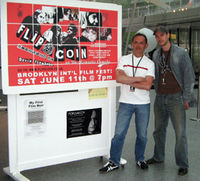"Flip A Coin" the movie at the BiFF
An interview with David and Leon Flamholc.
Published Jun 14, 2005
[an error occurred while processing this directive]
Edit page New page Hide edit links
David’s first film House of the Tiger King was selected by indiewire.com as one of the top 15 films undistributed films of 2004.
On Saturday evening I had the pleasure of meeting father-and-son filmmaking team David and Leon Flamholc. We talked about their latest project, Flip A Coin, which was written and directed by David, and produced by Leon.
David’s first film House of the Tiger King was selected by indiewire.com as one of the top 15 films undistributed films of 2004. Despite this accolade, he is finding it difficult (like many other independent filmmakers) to work his way through the veritable minefield of distribution issues. “They don’t seem to offer any money up front” he explains of distribution companies. “They hold the rights to your film for a very long time. And if they haven’t done anything with it and, say, a television deal comes along, you’re stuck with the original contract.” Rather than making do with a distribution deal that he feels is one-sided, David has taken the decision to sell DVD copies of the film himself.
The production phase of the film was not free from problems either. Most of Flip A Coin features actors riding around London on a Vespa scooter, and David decided to give his actors a few days to get to grips with the machine before production commenced. The day before filming was set to begin they not only crashed, but crashed in one of the busiest areas of London. Both actors had to go to hospital, and ended up limping around set for a few days.
David travelled all the way from Europe for the US premiere of this London-based romantic comedy. “The buzz we get from America is that they like this kind of movie from England. It’s a little different than, say, Lock Stock and Two Smoking Barrels.” The look and feel of Flip A Coin is inspired by the French New Wave, telling the story of a crime that isn’t really real, and focuses on the interaction between the main characters.
David’s father Leon (who produced the movie) explains that they shot the film using a combination of Super16 (choosing Kodak Vision 2 film stocks) and mini-DV (a Sony VX2000). This VX2000 was the same one that they had used in the jungles of Peru for House of the Tiger King. Having been serviced twice, the camera has now been retired.
David likes the grain of film. “In fact, when you go to film festivals these days most of the films are shot on DV and when you see film it’s like, wow, that looks really cool.” He believes that “film looks new and cool when you haven’t seen it for a while.”
56 mini-DV tapes (of 60 min each) and 40 rolls of film (totaling 400 minutes of super16 film) were used during the production of the film. The footage was then transferred to Digibeta, down-converted and edited on DV. The Edit Decision list from Final Cut Pro was used to capture the digibeta masters for their final output, David explained.
There are a lot of cool graphic sequences in the film. In fact, for me, one of the most enjoyable elements of the movie is the way that the editing flips back and forth between the stylized animation, and then jumps right back to film.
[In Technology]
Additional Events at ProFusion 2011, DV Expo East, and Columbia College Chicago May 26, 2011
[In Resources]
Fest to fete special guests Vera Farmiga, Paul Haggis; Mike O’Malley joins Anne Meara as hosts of Late Night Storytelling May 26, 2011






Add a Comment
Please be civil.